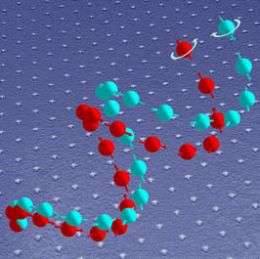Researchers Observe Magnus Effect in Light for First Time

(PhysOrg.com) -- Researchers at the Technion-Israel Institute of Technology have become the first to observe the Magnus effect in light, potentially opening a new avenue for controlling light in nanometer-scale optical devices, which could lead to much faster computation data processing. The discovery also provides a more precise way to study important physical behavior that until now could only be observed in relatively complex, messy condensed matter systems. The findings are published in the December 2008 issue of Nature Photonics.
The research was carried out by Prof. Erez Hasman, Dr. Konstantin Y. Bliokh, Dr. Vladimir Kleiner and Avi Niv from the Micro and Nanooptics Laboratory, Faculty of Mechanical Engineering and Russell Berrie Nanotechnology Institute at the Technion.
The Magnus effect can be observed in a wide range of systems. It describes, for example, the sideways force a spinning ball feels as it travels through the air, which explains why a baseball pitcher's curveball curves, and why a badly hit golf ball slices. Light waves, which are made up of massless particles called photons, have their own version of spin. Light's spin depends on whether its polarization, or direction of wave vibration, rotates in one direction or in the opposite direction as it travels. The Magnus effect for light (also called the spin Hall effect) causes the light to deflect due to the interaction between the light's spin and shape of the light's trajectory.
Prof. Hasman and his collaborators detailed a unified theory of this effect, and also made the first experimental observation of it. The potential extensions of their work are wide ranging. "Utilizing this effect in photonic and nano-optic devices may lead to the development of a promising new area of research called Spinoptics," says Prof. Hasman. "The hope is that we will be able to control light in all-optical nanometer scale devices in ways that were impossible before. Such devices could one day be used in all-optical nanometer scale devices that compute and process data faster than anything available today."
The researchers also believe their ongoing work can provide results that are useful to other fields of physics. According to Prof. Hasman, "There are a number of systems where the spin of a particle couples with its trajectory in high-energy and condensed matter physics. The math is the same in all cases, but experimentally it's very hard to understand what's going on. Our experimental system offers a new way to get at some of these fundamental questions clearly and precisely."
Provided by Technion-Israel Institute of Technology





















